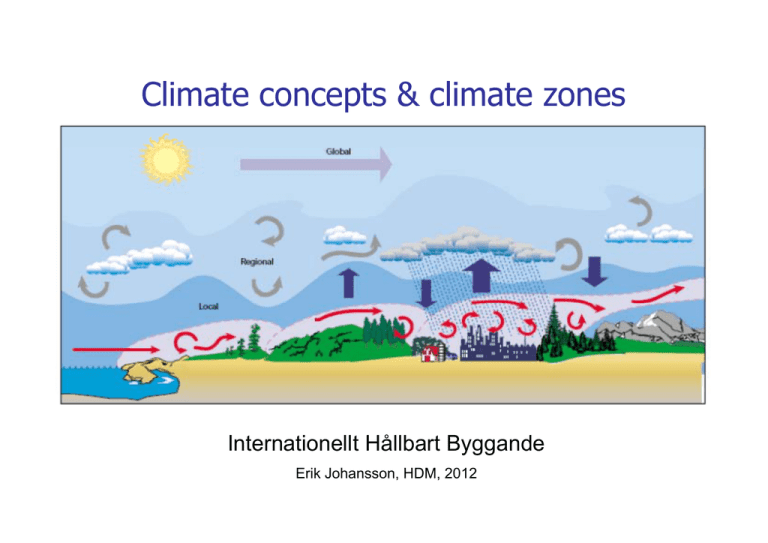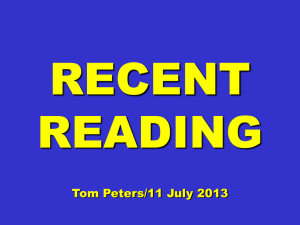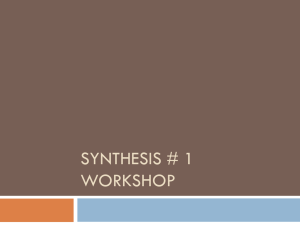Cli t t & li t Climate concepts & climate zones
advertisement

Cli t concepts Climate t & climate li t zones Internationellt Hållbart Byggande Erik Johansson, HDM, 2012 Contents Climate elements Climate zones Exercise: climate analysis Erik Johansson, HDM 2 Climatic elements Solar radiation (shortwave) Thermal radiation (longwave) Cloud cover Temperature Rainfall H idit Humidity Wind Erik Johansson, HDM 4 The sun-atmosphere-earth p system 18 jan-10 Erik Johansson, HDM 5 The atmosphere Total height: 100 km (Earth’s radius = 6400 Ozone layer: 15 – 35 km altitude The troposphere k ) km) Lower part off the atmosphere: 8–18 km above the Earth’s surface Temperature from +15 (Earth) to –53°C (upper boundary) Erik Johansson, HDM 6 The troposphere Is the zone where “weather” occurs: winds, clouds, water, pollution Contains 75% of the mass of the atmosphere: nitrogen, oxygen, water, carbon dioxide (CO2), ozone Erik Johansson, HDM 7 Short- and longwave radiation Sun: shortwave radiation: 0.1-3 µm Ultra violet (UV) radiation Visible light Earth: longwave g radiation: infrared radiation ((IR), ) 3-80 µ µm “Low” temperature radiation 18 jan-10 Erik Johansson, HDM 9 Heating g and cooling of the earth 18 jan-10 Erik Johansson, HDM 11 Heating g and cooling of the earth 18 jan-10 Erik Johansson, HDM 12 Ways y to measure solar radiation Sunshine duration (hours) Energy/time and surface units Daily total irradiation (MJ/m², day) Continuous (hourly) irradiation (W/m²) (W/m ) (1 W/m² = 1 J/s,m²) Erik Johansson, HDM 13 Sunshine duration Piteå, 65°N (northern Sweden) 0 10 Los Angeles, 34°N Dec: June: Jan: July: 7 12 Kuala Lumpur, p , 3°N Dec: June: 5 7 Erik Johansson, HDM 14 Hourly radiation (on a horizontal surface) W/m² W/m Solar radiation in Fez, Fez Morocco 1000 Summer 800 Winter 600 400 200 00 :0 0 03 :0 0 06 :0 0 09 :0 0 12 :0 0 15 :0 0 18 :0 0 21 :0 0 00 :0 0 0 Erik Johansson, HDM 15 Thermal radiation (low temp.) All bodies radiate heat according to th fformula: the l Q ((W/m 2 ) T 4 where T (K) = T(°C)+273 ( = 5.67·10 ( 5 67 10-88 W/m W/ 4K, K 0.9) 0 9) Erik Johansson, HDM 16 Radiation of heat Surface S f temperature 0°C Radiation R di ti (W/m²) 280 20°C 20 C 380 40°C 490 Erik Johansson, HDM 17 Daytime heating of the air SW–LW radiation convection conduction Erik Johansson, HDM 18 Surface absorptivity Reflectivityy ((albedo)) of different surfaces Bare soil: 5–40% (dark/light) Forest 5–20% 5 20% Grass 16–26% (long/short) Fresh snow: 95% Erik Johansson, HDM 19 Cooling by night LW radiation convection conduction Erik Johansson, HDM 20 Effect of clouds Less incoming solar radiation – lower heating by day Less outgoing longwave radiation – lower cooling by night Erik Johansson, HDM 22 Diurnal temperature variations clear l day d cloudy day Erik Johansson, HDM 23 Humidity Air contains water vapour Ways to measure humidity in the air: Relative humidity (% of saturation) Absolute humidity (g moisture/kg air) Vapour Pressure (hPa) Erik Johansson, HDM 24 Max. moisture content vs. air temperature Erik Johansson, HDM 25 Relative humidity Absolute Ab l t humidity (g/kg) Temperature (°C) Erik Johansson, HDM 26 Relative humidity Absolute Ab l t humidity (g/kg) Temperature (°C) Erik Johansson, HDM 27 Winds Winds blow from higher to lower pressures The wind direction is modified due to the Earth’s rotation, friction at the Earth’s surface, etc. Erik Johansson, HDM 28 Winds: global circulations 18 jan-10 Erik Johansson, HDM 29 Winds: monsoons The result of temperature differences of the continents and the oceans 4-5 4 5 months N direction direction, 4 4-5 5 months S direction Erik Johansson, HDM 30 Area affected byy the monsoons 18 jan-10 Erik Johansson, HDM 31 Summer monsoon 18 jan-10 Erik Johansson, HDM 32 Winter monsoon 18 jan-10 Erik Johansson, HDM 33 Local sea breeze Sunny afternoons Erik Johansson, HDM 34 Ocean currents 18 jan-10 Erik Johansson, HDM 35 El Niño Varmare strömmar i östra Stilla havet runt jultid Varmare ytvatten mer regn i västra Sydamerika Starka El Niño-år kan påverka klimatet på hela jorden Erik Johansson, HDM 37 La Niña Motsatsen till El Niño (kallare strömmar) Vindarna från Stilla havet mot Australien är starkare Mer vatten förs mot Australiens kust – kraftig molnbildning Australiska kontinenten får betydligt mer y får torka)) nederbörd ((Sydamerika Erik Johansson, HDM 38 Heating g and cooling of the earth 18 jan-10 Erik Johansson, HDM 40 Greenhouse gases Water vapour Carbon dioxide (CO2) Methane Nitro s o Nitrous oxides ides Ozone CFCs Erik Johansson, HDM 41 Climate zones Erik Johansson, HDM 42 Parameters affecting g climate zones Latitude Altitude Low and high pressure zones Global wind ind patterns Proximity to oceans and large seas Ocean currents Erik Johansson, HDM 44 Latitude zones Tropic of Capricorn: -23.5° Tropic of Cancer: +23.5° Erik Johansson, HDM 45 Incoming g and outgoing g g radiation at different latitudes 18 jan-10 Erik Johansson, HDM 46 Latitude zones Low latitudes: 0-30°N/S Mid-latitudes: 30°N/S-60°N/S High latitudes: >60°N/S >60 N/S Erik Johansson, HDM 47 Köppen’s climate classification Main catagories: A. Equatorial (warm humid) B Arid (hot dry) B. C. Temperate D. Cold temperate E Arctic E. H. Mountain climates Erik Johansson, HDM 48 Köppen’s climate classification Erik Johansson, HDM 49 Atkinson (Modified Köppen) 1. Cold 2. Temperate (moderate) 3. Hot dry Maritime desert climate 4. Warm humid Warm humid island climate Sub-types: Composite/monsoon climate Tropical highland climate Erik Johansson, HDM 50 Simplified climate zone classification according to Köppen Erik Johansson, HDM 51 1 – Cold Moscow ((Russia), ), 56°N Erik Johansson, HDM 52 2 – Temperate Rome ((Italy), y), 42°N Erik Johansson, HDM 53 4 – Warm humid (equatorial) Brazzaville ((Congo), g ), 4°S Erik Johansson, HDM 54 Warm humid (monsoon) Bombay y (India), ( ), 18°N Erik Johansson, HDM 55 3 – Hot dry (arid) Alice Springs p g ((Australia), ), 23°S Erik Johansson, HDM 56






